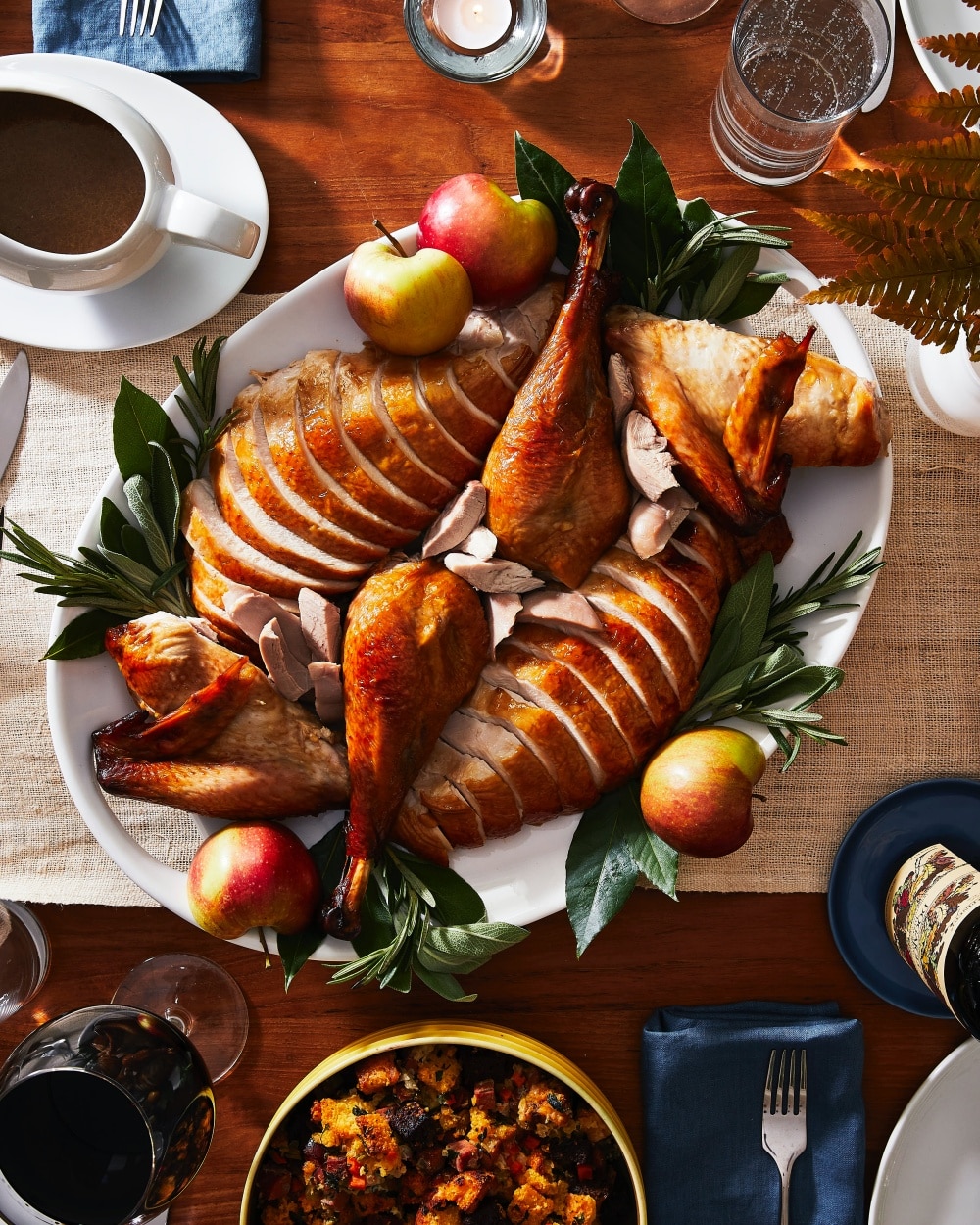Molasses-Brined Spatchcocked Turkey with Cider Glaze
A molasses brine gives this spatchcocked turkey a rich depth, while a cider glaze adds zing. Spatchcocking, or butterflying, lets the bird cook more evenly in a single layer, yielding crispier skin and tender breast meat.

Molasses-Brined Spatchcocked Turkey with Cider Glaze
Photo Credit : Joe St. Pierre | Food Styling by Joy Howard | Prop Styling by Ann LewisA molasses brine gives this spatchcocked turkey a rich depth, while a cider glaze adds zing. Spatchcocking, or butterflying, is simply cutting out the backbone of a turkey or chicken and pressing the bird flat so that it cooks more evenly in a single layer. You get crispier skin and tender breast meat. You can ask your butcher to do the spatchcocking for you, or use a sharp knife or kitchen shears to do it yourself (watch a video if doing it for the first time).
Note:Our turkey recipe calls for a natural (unbrined) bird. If using a prebasted, injected, or kosher bird, skip the brining ingredients and instructions.
From “A New New England Thanksgiving,” November/December 2020
Yield:
8 to 10 servingsFor the brine
Ingredients
7 quarts water
1 3/4 cups kosher salt
2 cups molasses
3 medium onions, peeled and cut into quarters
1 knob of ginger, about 2 1/2 inches long, peeled and thinly sliced
Instructions
On the morning of the day before Thanksgiving, prepare your brine: In a very large pot (such as a lobster pot), stir the water, salt, and molasses until the salt is dissolved. Add the onions and ginger.
Remove the neck and giblets from the turkey, then submerge it in the brine. If you don’t have a pot large enough to hold the bird, use two brining bags (double-bagged) in a roasting pan. Brine the turkey for 8 to 12 hours.
Remove the turkey from the brine and pat it dry, and lay it skin side up on a rack in your roasting pan. Let it sit, uncovered, in your refrigerator overnight. This will result in a very crispy skin.
On Thanksgiving morning, remove the turkey from the refrigerator and let rest at room temperature for 1 hour. Preheat the oven to 300°. The turkey should be skin side up on the rack, with the wingtips tucked underneath the breast and the leg bones angled in so the whole bird fits in the pan. Scatter the onions around. Transfer to the oven.
For the turkey and glaze
Ingredients
1 13-to-15-pound natural turkey, thawed and spatchcocked (see Note)
2 medium onions, peeled and quartered
2 cups cider
1/2 cup dark brown sugar
3 tablespoons cider vinegar
1 tablespoon Dijon mustard
Instructions
Meanwhile, prepare the glaze: In a medium saucepan over medium-high heat, whisk together the cider, brown sugar, vinegar, and mustard. Bring to a boil, then reduce heat to a simmer and let the mixture cook down and thicken until you have 2/3 cup, about 25 to 30 minutes.
After 2 1/2 to 3 hours of roasting, check the temperature at the deepest part of the breast. It should be about 150°. If not, let it roast another 15 minutes and check again. At this point, brush glaze all over the top of the turkey and increase the heat to 350°. Cook for 15 minutes, then glaze again. Cook for another 10 minutes, glaze once more, and check the temperature. The meat in the deepest part of the breast should be 160° and the thigh should be 170°; if not, let it cook another 10 minutes. Remove from the oven and let rest at room temperature for at least 30 minutes. Save the remaining glaze for the sauce.
For the sauce
Ingredients
Pan drippings
Remaining glaze
1 cup reduced-sodium chicken stock, plus more as needed
3 tablespoons salted butter
Instructions
Now, make the sauce: Strain the drippings from the pan into a gravy separator and pour off the fat. You should have about 2 cups of drippings. If not, add a bit of chicken stock. Put the drippings in the pan with the remaining glaze and 1 cup chicken stock. Simmer until thick enough to coat the back of a spoon, about 10 to 15 minutes. Whisk in the butter.
Carve the turkey and serve with the sauce.


